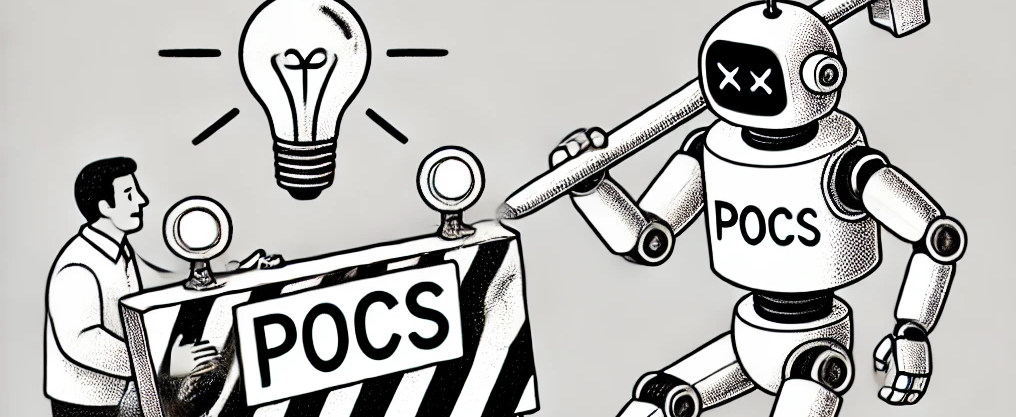Generative AI holds immense promise to revolutionize business, yet the overreliance on Proof of Concepts (PoCs) is stifling its potential. PoCs are meant to demonstrate the feasibility of AI solutions, but more often than not, they lead to wasted budgets, negative sentiment, and stalled projects. This cycle is not just slowing down progress; it’s creating skepticism around the viability of Generative AI. Instead of focusing on PoCs, teams should be building Minimum Viable Products (MVPs) – the first versions of production deployments. A mindset shift from PoCs to MVPs can unlock the true potential of AI, driving innovation and delivering real value.
“Although the potential for success is enormous, delivering business impact from AI initiatives takes much longer than anticipated. IT leaders responsible for AI are discovering “AI pilot paradox,”’ where launching pilots is deceptively easy but deploying them into production is notoriously challenging.”
Chirag Dekate, Senior Director Analyst, Gartner
The Pitfalls of PoCs
PoCs often fail to reach production due to several reasons. Firstly, the tools and processes used for PoCs are usually different from those needed for production. This mismatch means that when a project transitions from PoC to production, it often requires a complete redevelopment, wasting time and resources.
PoCs are typically built quickly, prioritizing speed over long-term maintainability. This approach leads to technical debt, which can be hard to address later. Additionally, the infrastructure used in PoCs is often not robust enough for production, necessitating substantial upgrades.
Resource constraints are another major issue. PoCs operate on limited resources, which are insufficient for full-scale production. While a PoC might perform well under controlled conditions, scaling it up to handle real-world data and user loads can reveal significant shortcomings. Furthermore, funding for PoCs might not extend into the production phase, leading to resource shortages.
Data issues also play a significant role. The data used in PoCs is often a small, curated subset that doesn’t reflect the complexities of real-world data. When moving to production, issues such as data quality, quantity, and accessibility become significant hurdles. Ensuring data privacy and security in a production environment adds another layer of complexity not addressed in the PoC phase.
Stakeholder buy-in is crucial for transitioning from PoC to production. Without strong support from executives, this transition can lack the necessary backing. Additionally, if the PoC does not clearly demonstrate a strong return on investment (ROI), it may fail to get the necessary approval for production deployment.
There’s also the challenge of business alignment. PoCs can become isolated experiments that do not align with the broader business objectives. If the PoC does not integrate seamlessly with the company’s strategic goals, it is unlikely to receive the investment needed to transition to production. Business priorities can shift, leaving PoCs orphaned.
Technical challenges further complicate the transition. Integrating the AI solution with existing IT systems can be complex and resource-intensive. Ensuring that the AI model performs well in a real-world, production environment can be significantly more challenging than in a controlled PoC environment.
Operational expertise is another critical factor. Moving from a PoC to production requires operational expertise that may not be present in the team that developed the PoC. Production systems require ongoing maintenance and support, which may not be planned for during the PoC phase.
Lastly, ethical and regulatory concerns become more critical in production. Compliance with regulations such as GDPR or HIPAA can be complex and time-consuming, often overlooked until the production phase, causing delays or even halting progress.
The Case for MVPs
Instead of investing in PoCs that rarely transition to production, teams should focus on building Minimum Viable Products (MVPs). An MVP is a functional version of the product with just enough features to be deployed in a production environment.
MVPs are designed with production in mind from the start, using scalable tools and processes that can handle real-world demands. This approach reduces the need for redevelopment and ensures better alignment with business goals, increasing the likelihood of stakeholder buy-in.
By building an MVP, teams can better allocate resources, ensuring that investments are made in areas that will have a direct impact on the product’s success. This approach avoids the waste often associated with PoCs that never see the light of day.
Designing for production from the start means that ethical and regulatory concerns are addressed early in the development process, reducing the risk of compliance issues later on.
SmartSpace: The Solution
SmartSpace offers a solution to the challenges of transitioning from PoCs to production. By leveraging the SmartSpace platform, organizations can build MVPs that are ready for production from day one.
SmartSpace enables rapid prototype development and simple production deployments with its “Symphony Framework” that commoditizes the infrastructure and orchestration layer. This removes the time and effort required to build out infrastructure, allowing teams to focus on developing their AI solutions.
Our platform allows customers to use shared, enterprise-grade AI infrastructure to quickly and securely build apps for any use case, accessing any data, and powered by any AI model. Best of all, because everything is managed on a single platform, these apps work together seamlessly.
By using SmartSpace, organizations can ensure that their AI initiatives are not only feasible but also impactful and sustainable. This approach allows businesses to move beyond the limitations of PoCs and fully realize the potential of Generative AI in transforming industries and driving innovation.
Conclusion
Relying on PoCs as a stepping stone to production is proving to be ineffective for many Generative AI projects. The future of AI development lies in creating MVPs that are designed to scale, integrate, and provide real business value from day one. SmartSpace offers the tools and infrastructure needed to make this transition, ensuring that AI projects are both successful and sustainable.
It’s time to move beyond PoCs and embrace MVPs as the standard for AI development. Only then can we fully realize the potential of Generative AI in transforming industries and driving innovation.
